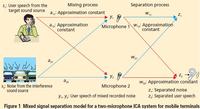Terminator3
Advanced Member level 3
There is an interesting thing called ICA (independent component analysis).
What if we make patch array antenna, put capacitor on each patch feeding and schottky diode. In this way we can get separate DC signal from every single patch, as self-mixing occurs in patch. Then next step is to wire all this DC outputs to modern ARM (stm32, nxp, etc..) with multiple ADC inputs, and perform ICA analysis. If you google on ICA for microphone arrays, it may be feasible. Super performance receiving signals with huge interference. Patch signals does not require to be in-phase, as we perform ICA. It is well known and studied on microphone arrays, etc. Bad thing is there is no gain for single patch, but it can be solved by making array of arrays.
Idea behind this is to overcome SNR vs DIRECTIVITY problem, huge interference problem, poor performance problem. If we make array too large, then beam will too narrow, and in many applications impossible to align beam of TX/RX systems. Some interference make impossible to work in traditional way. Some systems have too poor performance, and improving arises cost problem.
For example, 3x3 patch array, 9 patches, 9 schottky diodes, 9 capacitors for DC block, 9 capacitors for low frequency AC, some cheap Cortex microprocessor with 9 ADC channels (single ADC multiple channels). DSP using ICA method.
What if we make patch array antenna, put capacitor on each patch feeding and schottky diode. In this way we can get separate DC signal from every single patch, as self-mixing occurs in patch. Then next step is to wire all this DC outputs to modern ARM (stm32, nxp, etc..) with multiple ADC inputs, and perform ICA analysis. If you google on ICA for microphone arrays, it may be feasible. Super performance receiving signals with huge interference. Patch signals does not require to be in-phase, as we perform ICA. It is well known and studied on microphone arrays, etc. Bad thing is there is no gain for single patch, but it can be solved by making array of arrays.
Idea behind this is to overcome SNR vs DIRECTIVITY problem, huge interference problem, poor performance problem. If we make array too large, then beam will too narrow, and in many applications impossible to align beam of TX/RX systems. Some interference make impossible to work in traditional way. Some systems have too poor performance, and improving arises cost problem.
For example, 3x3 patch array, 9 patches, 9 schottky diodes, 9 capacitors for DC block, 9 capacitors for low frequency AC, some cheap Cortex microprocessor with 9 ADC channels (single ADC multiple channels). DSP using ICA method.
